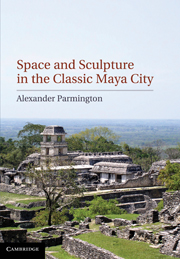Book contents
- Frontmatter
- Contents
- List of illustrations
- List of tables
- Summary
- Acknowledgements
- Introduction
- 1 Defining the Maya built environment
- 2 Investigative considerations and methodology
- 3 Access analysis of the Palenque Cross Group and its sculpture
- 4 Architectural and sculptural programs of the Palenque Palace Group
- 5 Access analysis of the architectural and sculptural programs of the Palenque Palace Group
- 6 Access analysis of Maya art and architecture: Summary and conclusions
- Appendixes 1–7
- Bibliography
- Index
3 - Access analysis of the Palenque Cross Group and its sculpture
Published online by Cambridge University Press: 05 August 2011
- Frontmatter
- Contents
- List of illustrations
- List of tables
- Summary
- Acknowledgements
- Introduction
- 1 Defining the Maya built environment
- 2 Investigative considerations and methodology
- 3 Access analysis of the Palenque Cross Group and its sculpture
- 4 Architectural and sculptural programs of the Palenque Palace Group
- 5 Access analysis of the architectural and sculptural programs of the Palenque Palace Group
- 6 Access analysis of Maya art and architecture: Summary and conclusions
- Appendixes 1–7
- Bibliography
- Index
Summary
Applying the methods discussed in Chapter 2, my goal in Chapter 3 is to demonstrate, using a simple example, how “access analysis” of architecture and associated sculpture can be used to distinguish societal boundaries in Classic Maya city centres, before proceeding to more complicated architecture and methodological procedures in later chapters. The building group focused on in this chapter is the Cross Group at Palenque. Following a brief introduction to the site of Palenque, a general description of the buildings and sculpture that comprise the Cross Group will be presented in accordance with Schele and Freidel (1990: 237–261), Greene Robertson (1991: 9–54), and Stuart (2006: 86–190). Following the introductory section, the results of a spatial analysis of the Cross Group temples and associated sculpture will be presented.
Situated in the southern Mexican state of Chiapas, the site of Palenque is positioned in the foothills of the northern slope of the Sierra de las Naranjas, on the southwest periphery of the Maya region (Maudslay 1889–1902b: 8; Sharer 1994: 276). Placed strategically on a high natural platform overlooking low fertile plains (Andrews 1975: 168), Palenque's core measures approximately 2.2 km2. The site's settlement density is estimated to have once been the second highest in the Maya area, averaging 673 structures per square kilometre (Copán is purported to have had the highest density at 1,449 structures in a 0.6 km2 area) (Barnhart 2001: 73).
- Type
- Chapter
- Information
- Space and Sculpture in the Classic Maya City , pp. 48 - 67Publisher: Cambridge University PressPrint publication year: 2011



